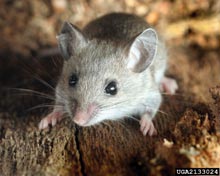
David Cappaert , Michigan State University
Deer Mouse
General Description
Deer mice are rodents with relatively large ears and large eyes. They are slightly larger than the house mouse
and have hairy, bi-colored tails that are dark on top and white on the underside. The belly and feet of the deer
mouse are pure white, but the head, back and sides vary from grey to brown. Deer mice are nocturnal and
primarily feed on seeds. In the wild they can be numerous and occupy a wide variety of habitats, but are seldom
seen. When they enter structures, Deer mice can be quite destructive to upholstered furniture, shredding fabric
and stuffing to make nests. In a single year, a female may have three or four litters of three to six young each.
Through their urine, feces and saliva, deer mice can transmit hantavirus, a pathogen that can produce a serious, life-threatening illness. When entering structures contaminated with deer mouse excreta, precautions should be taken to avoid contact with dead mice and their excreta, and to avoid inhaling airborne hantavirus particles. Keeping homes and buildings rodent-free is especially important in rural and less urbanized areas where deer mice are prevalent.
General Control
Effective mouse control involves sanitation, mouse-proofing and population reduction. Reduction techniques
include trapping and baiting. Proper placement of traps and bait stations are important. Place the traps with the
trigger side next to the walls. Place bait stations with the openings close to a wall. The use of tamper-resistant
bait stations helps prevent accidental poisoning of children, pets and non-target animals.









